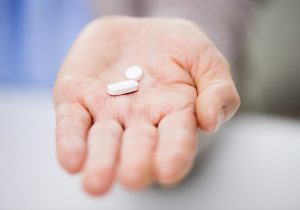 The main goal of hospice care is to increase patients’ comfort and enhance their quality of life. Hospice organizations do this through a wide range of services – from nursing care to social work, caregiver training to companionship, spiritual support to therapeutic massage.
The main goal of hospice care is to increase patients’ comfort and enhance their quality of life. Hospice organizations do this through a wide range of services – from nursing care to social work, caregiver training to companionship, spiritual support to therapeutic massage.
Medication can also be a vital part of hospice care, helping to relieve common end-of-life symptoms such as pain, shortness of breath, anxiety and nausea, among others. Easing these discomforts enhances patients’ well-being, enabling them to make the most of their remaining time.
However, patients and families don’t always understand why a medicine has been prescribed, and may have concerns about certain drugs. This article will review the most common hospice medications, how they help patients, and how to reduce any risks from the drugs. If you have additional questions and would like to speak with a hospice nurse 24/7, click here.
Common Hospice Medications: Over-the-Counter
Acetaminophen (pronounced uh-SEE-tuh–MIN–uh–fin) is the most-prescribed hospice medication. Known by the brand name Tylenol, it is used to reduce fever and mild to moderate pain. Acetaminophen can be taken in a pill by mouth, or via a rectal suppository.
 Side effects are rare, but serious reactions can include nausea, pain in the upper stomach, itchiness, loss of appetite, dark urine, clay-colored stools, or jaundice (yellowing of the skin or eyes). Acetaminophen should not be taken with certain drugs, which could cause dangerous interactions. These include warfarin (Coumadin), isoniazid (Laniazid, Nydrazid), diflunisal (Dolobid), carbamazepine (Tegretol), phenobarbital (Luminal), and phenytoin (Dilantin).
Side effects are rare, but serious reactions can include nausea, pain in the upper stomach, itchiness, loss of appetite, dark urine, clay-colored stools, or jaundice (yellowing of the skin or eyes). Acetaminophen should not be taken with certain drugs, which could cause dangerous interactions. These include warfarin (Coumadin), isoniazid (Laniazid, Nydrazid), diflunisal (Dolobid), carbamazepine (Tegretol), phenobarbital (Luminal), and phenytoin (Dilantin).
Bisacodyl (biz-AK-oh-dill) is used to treat constipation, an uncomfortable condition that’s common among hospice patients as they eat and drink less over time, and take other hospice medications. Brand names of this laxative include Carter’s Little Pills, Correctol, Dulcolax, Feen-A-Mint, and Fleet Bisacodyl.
Bisacodyl stimulates the intestines to cause a bowel movement. It normally takes effect in 6 to 12 hours, so it is often given the night before a bowel movement is desired. The medication should not be taken more than once a day or for more than a week without talking to your doctor. It should not be taken within an hour after consuming dairy products or antacids.
Side effects can include stomach cramps or discomfort, and faintness. If any of these symptoms are severe or don’t go away, notify your doctor. If you experience rectal bleeding – a more serious side effect – call your doctor right away.
Common Hospice Medications: Prescription Needed
Avoid a Tragedy: Store Your Medication Safely
To protect young children from poisoning, keep all medications out of their sight and reach, and always lock safety caps immediately.
Be aware of items that are not child-resistant — such as weekly pill minders, eye drops, creams, patches, and inhalers — as little ones can easily open them.
Dexamethasone (DEX-uh-METH-uh-sone) is a steroid used for multiple purposes. Brand names include Decadron, Dexamethasone Intensol, and Dexpak Taperpak. For hospice patients, it can relieve pain, reduce swelling, increase appetite and relieve nausea. It’s also used to treat certain forms of arthritis; skin, blood, kidney, eye, thyroid, and intestinal disorders (such a colitis); severe allergies, asthma, and certain cancers. Dexamethasone is similar to a hormone the body naturally produces, and can replace this chemical when the body doesn’t make enough.
Dexamethasone is taken by mouth in either pill or liquid form, and should be taken with milk or food to avoid stomach upset. Your doctor may also instruct you to follow a special diet while taking dexamethasone.
Serious side effects of this common hospice medication can include skin rash; swollen face, lower legs, or ankles; vision problems; a long-lasting cold or infection; muscle weakness; and black or tarry stool. Other reactions can include upset stomach, vomiting, headache, dizziness, insomnia, restlessness, depression, anxiety, and easy bruising.
Talk to your doctor before stopping the drug, which should be decreased gradually. If dexamethasone is stopped abruptly, the patient can have serious reactions including loss of appetite, upset stomach, vomiting, drowsiness, confusion, headache, fever, joint and muscle pain, peeling skin, and weight loss.
Looking for more information about hospice?
Read Samaritan’s Hospice Eligibility Criteria to learn about who qualifies for hospice care, our admission process, and other details.
 Lorazepam (lore-AY-zuh-pam) reduces anxiety, agitation, shortness of breath, and insomnia. Commonly available under the brand name Ativan or Lorazepam Intensol, it comes in either a tablet or liquid and is taken by mouth.
Lorazepam (lore-AY-zuh-pam) reduces anxiety, agitation, shortness of breath, and insomnia. Commonly available under the brand name Ativan or Lorazepam Intensol, it comes in either a tablet or liquid and is taken by mouth.
Lorazepam is the second most-prescribed hospice medication. It can be given alongside morphine (described below) if needed for comfort.
Lorazepam can cause dangerous interactions with other drugs, so make sure to tell your doctor about any other medications you’re taking. Do not drink alcohol or use street drugs, which can also cause serious interactions with Lorazepam. Symptoms of a dangerous drug interaction include unusual dizziness, lightheadedness, extreme sleepiness, slowed or difficult breathing, or unresponsiveness.
Long-term use can make Lorazepam less effective. However, talk to you doctor before stopping this medication, as suddenly going off Lorazepam can cause worsening anxiety and other problems.
Side effects of Lorazepam can include drowsiness, dizziness, tiredness, weakness, dry mouth, diarrhea, constipation, nausea, changes in appetite, restlessness or excitement, difficulty urinating, frequent urination, blurred vision, and changes in sex drive or ability.
Contact your doctor immediately if you experience any serious side effects, such as shuffling walk; persistent, fine tremor or inability to sit still; fever, difficulty breathing or swallowing, severe skin rash,
If you have any questions about common hospice medications prescribed during inpatient hospice care in South Jersey, please call Samaritan at (856) 596-1600.
 Haloperidol (hal-oh-PER-uh-dol) helps reduce agitation and nausea. Known by the brand name Haldol, it also treats certain psychiatric conditions and hyperactivity in children. It should not be given to patients with seizure disorders, because it can increase the frequency or severity of seizures. In general, people with Parkinson’s disease should not take haloperidol, and older adults with dementia who take haloperidol have an increased chance of death during treatment. The medication can also be dangerous for people with other conditions, so be sure to give your doctor your full medical history.
Haloperidol (hal-oh-PER-uh-dol) helps reduce agitation and nausea. Known by the brand name Haldol, it also treats certain psychiatric conditions and hyperactivity in children. It should not be given to patients with seizure disorders, because it can increase the frequency or severity of seizures. In general, people with Parkinson’s disease should not take haloperidol, and older adults with dementia who take haloperidol have an increased chance of death during treatment. The medication can also be dangerous for people with other conditions, so be sure to give your doctor your full medical history.
yellowing of the skin or eyes, or irregular heartbeat.
Haloperidol is available in a tablet or a liquid to be taken by mouth. Do not stop taking this hospice medication without talking to your doctor. If you suddenly stop taking haloperidol, you may have trouble controlling your movements, so your doctor will probably decrease your dose gradually.
Haloperidol can cause dangerous interactions with other medications, nutritional supplements, and herbal products, so tell your doctor about anything else you’re taking.
This medication may cause dizziness, lightheadedness, and fainting when you get up too quickly from a lying position. Alcohol can make haloperidol’s side effects worse. Serious side effects include confusion, dizziness, fainting, fast or pounding heartbeat, flu-like symptoms, high fever, restless or rigid muscles, seizures, sweating, and tremors.
Morphine (MOR-feen) helps relieve moderate to severe pain and shortness of breath. It is the preferred hospice medication for pain. And it can prevent further breathing difficulties by decreasing shortness of breath.
 Morphine is in a class of medications called opioids and is available in both liquid and pill form. Brands include Roxanol, MS Contin, Arymo ER, Morphabond, MSIR, and Kadian.
Morphine is in a class of medications called opioids and is available in both liquid and pill form. Brands include Roxanol, MS Contin, Arymo ER, Morphabond, MSIR, and Kadian.
The most common side effects are sedation, mild nausea, and constipation. However, sedation and nausea often go away in a few days, as the body adjusts to the drug. Because morphine slows the bowel, stimulant laxatives are typically recommended to prevent constipation
Some people fear, or have heard, that morphine will cause the patient to stop breathing. However, this common hospice medication is very safe when given orally at the dose needed for symptom control, and increased slowly as needed for pain relief. Typically, changes in the patient’s breathing pattern or greater pain are caused by their illness advancing, rather than the drug.
Patients typically start at a very low dose, which is gradually increased until the person feels comfortable. The incidence of overdose in patients receiving hospice care, especially those with cancer, is low in part due to advanced age that is associated with lower risk of addiction. An additional factor is that hospice clinicians utilize gradual dose titration methods and prescribe opioids appropriately for those with moderate to severe pain.
People may also be afraid to take morphine because they fear becoming addicted. However, hospice patients have very little chance of addiction to morphine or other opioids. This is because their bodies usually have a large amount of pain receptors, which use up the drug for symptom relief. People who are not ill and take opioids can become addicted and feel high because they have few pain receptors to absorb the drug properly.
Morphine may not work for patients with advanced liver disease, since the drug is processed through the liver.
Morphine can cause dangerous interactions with other medications and substances, so tell your doctor if you take any other drugs or supplements. Drinking alcohol while taking morphine (or taking medications containing alcohol) can cause severe harm or death.
If you live in South Jersey and have questions about common hospice medications
for your loved one, please call Samaritan at (856) 596-1600.
 Contact your hospice nurse if any of the following side-effects are severe or don’t go away: drowsiness, stomach pain and cramps, dry mouth, headache, nervousness, mood changes, small eye pupils, difficulty urinating or pain when urinating.
Contact your hospice nurse if any of the following side-effects are severe or don’t go away: drowsiness, stomach pain and cramps, dry mouth, headache, nervousness, mood changes, small eye pupils, difficulty urinating or pain when urinating.
If you have any of these serious side-effects, seek medical attention immediately: slowed breathing, long pauses between breaths, shortness of breath, skin turns blue or purple, changes in heartbeat, fast heartbeat, agitation, hallucinations, fever, sweating, confusion, shivering, severe muscle stiffness or twitching, loss of coordination, effect on sexual activity, nausea, vomiting, diarrhea, loss of appetite, weakness, dizziness, seizures, fainting, chest pain, hives, rash, itching; swelling of the eyes, face, mouth, lips of throat; hoarseness, difficulty breathing or swallowing.
Do not stop taking morphine without talking to your doctor, as stopping the drug suddenly may cause withdrawal symptoms.
 Oxygen is not technically a medication, but it can be used as one. Often called O2, this colorless, odorless gas is essential for all cells in our body and helps healing. Supplemental oxygen also helps reduce shortness of breath and air hunger – the sensation of not being able to get enough air.
Oxygen is not technically a medication, but it can be used as one. Often called O2, this colorless, odorless gas is essential for all cells in our body and helps healing. Supplemental oxygen also helps reduce shortness of breath and air hunger – the sensation of not being able to get enough air.
Oxygen systems, which require a doctor’s prescription, come in two types: oxygen concentrators, which remain in the person’s room, and portable oxygen systems, which include a tank of either gas or liquid oxygen.
The patient or family should not change the liter flow (amount of oxygen flowing through the tubing) without talking with the patient’s nurse. Make sure to have at least a three-day supply of portable oxygen on hand, so it doesn’t run out.
Oxygen systems create an increased risk of fire and injury if not used correctly. Your hospice provider will give you a list of important precautions to ensure safety, including no smoking in a home, car, or other places where oxygen is used.
If you live in South Jersey and have questions about common hospice medications
for your loved one, please call Samaritan at (856) 596-1600.